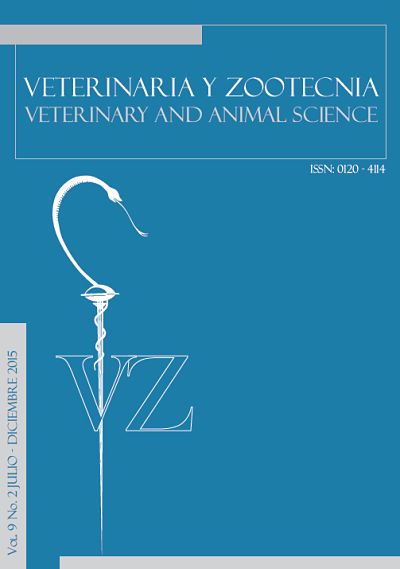Authors
Abstract
Seizures are one of the most difficult symptoms to control during intoxication because many drugs used have severe effects on the patient's behavior and significantly affect their mental state. The use of levetiracetam in the treatment of seizures in a canine intoxicated with organophosphate is described. A three-year-old German Shepherd male canine is treated with levetiracetam at a dose of 7 mg/kg orally every 12 hours following seizures caused by organophosphate intoxication. A patient that gave in to seizures with the established dose is found, improving its mental state without evidence of narcotic or hypnotic signs due to the use of anticonvulsive. The evaluation of alanine aminotransferase (ALT) shows normal value for canines as well as creatinine after its use, and the hemogram is also normal. The patient presented recurrence one month after therapy requiring an increase in the dose to 14 mg/kg every 8 hours and ends with 15 mg/kg every 12 hours for three months. The patient is monitored for nil alteration in ALT and creatinine three months after the therapy with levetiracetam was established. The use of levetiracetam in treatment of seizures in dogs in Colombia is described as an alternative less harmful than phenobarbital.
Keywords
References
Bevier, D. Insect and arachnid hypersensitivity. Dermatology, v. 29, n. 6, p. 1385-405, 1999.
Bohórquez, D.; Ciro-Martínez, L., Echavarria-Ospina, L., Mendoza, J., Ochoa Vélez, L., Vásquez, E. Oximes in cholinesterase -inhibitors poisoning. Rev CES Salud Pública, v.3, p. 242–250, 2012.
Bonhage, M.; Chilcoat, C.; Li, Q.; Melendez, V.; Flournoy, W. Evaluation of two scopolamine and physostigmine pretreatment regimens against nerve agent poisoning in the dog. J Vet Pharmacol Ther,v. 32, p. 146–153, 2008.
Brunton, L.; Lazo, J.; Parjer, K.L. Goodman & Gilman The Pharmacological basis of therapeutics, 11º.ed. New York: McGraw Hill, 2007. 2045p.
Córdoba, D. Toxicología.4ª. ed. Bogotá: Manuel Moderno, 2008. 1022p.
De Smedt, T.; Raedt, R.; Vonck, K.; Boon, P. Levetiracetam: The Profile of a Novel Anticonvulsant Drug—Part I: Preclinical Data. CNS Drug Rev, v.13, p.43–56, 2000.
Díaz-Rivera, E. Molecular and biochemical mechanisms of acaricide resistance in common cattle tick Rhipicephalus microplus. RCCA, v. 5, p. 72–81, 2012.
Dipiro, J.T.; Talbert, R.L.; Yee, G.C.; Matzke, G.R.; Well, B.; Posey, M.Pharmacotherapy: a pathophiologic approach. 9ª.ed. Missouri, USA: McGraw ill, 2014. 1053p.
Fernández A.D.; Mancipe G,L.; Fernández C,D. Organophosphorus poisoning.Rev Med, v. 18, p. 84–92, 2010.
Hardy, B.; Patterson, E.; Cloyd, J.: Hardy, R.; Leppik, I. Double-Masked, PlaceboControlled Study of Intravenous Levetiracetam for the Treatment of Status Epilepticus and Acute Repetitive Seizures in Dogs. J Vet Intern Med, v.26, p.334–340, 2012.
Hardy, B.T. Injectable Levetiracetam use in the dog. Minnesota, USA: University of Minnesota, 2012. 340 p. Tesis (Maestría).
Jambroszyk, M. Studies on canine epilepsy: diagnostic workup including advanced imaging techniques and new treatment modalities. Hannover, Alemanía: University Hannover, 2008. 77p. Tesis (pregrado).
Lee, J.A.; Welch, S.; 2013. When and how to use activated carbon. Vet. Med. 8, 28–33. Miller, W.; Griffin, C.; Campell, K.; 2012. Muller & Kirk. Small animal dermatology, 7º. ed. Saunders, San Diego.
Moeser, A.; Steinberg, S.A. Anticonvulsants. In: Adams, Moeser. Small animal critical care medice. Missouri: Saunders Elsevier, 2015. p. 872–876.
Moore, S.; Muñana, K.; Papich, M.; Nettifee-Osborne, J. The pharmacokinetics of levetiracetam in healthy dogs concurrently receiving phenobarbital. J Vet Pharmacol Ther, v. 34, p. 31–34, 2010.
Muñana, K.; Thomas, W.; Inzana, K.; Nettifee-Osborne, J.; McLucas, K.; Olby, N.; Mariani, C.; Early, P. Evaluation of Levetiracetam as Adjunctive Treatment for Refractory Canine Epilepsy: A Randomized, Placebo-Controlled, Crossover Trial. J Vet Intern Med, v. 26, p. 41–348, 2012.
Oliveira-Sequeira, T.; Martins Amorim, R.; Secorun Borges, A.; Reis Brant, M. Eficácia terapêutica e residual de seis formulações insecticidas sobre o parasitismo por larvas de Dermatobia hominis em bovinos. Vet E Zootec, v. 21, p.177–186, 2014.
Patterson, E. Status Epilepticus and Cluster Seizures. Vet Clin Small Anim, v. 44, p. 1103–1112, 2014.
Plumb, D.C. Plumb´s Veterinary Drug Handbook. 7º.ed. Iowa, USA: Wileyblackwell, 2011. 1594p.
Restrepo-Salazar, J.G. Toxicología básica veterinaria. Aspectos básicos.1º.ed. Medellín, Colombia: CIB, 2011. 325p.
Verneu, K.M. Seizures and status epilepticus. In: Karen, Verneu. Small animal critical care medice. Missouri, USA: Saunders, Missouri, 2015. p. 426–431.
Wismer, T.; Means, C. Toxicology of Newer Insecticides in Small Animals. Vet Clin Small Anim, v. 42, p. 335–347, 2012.
Ziółkowski, H., Jaroszewski, J., Ziółkowska, N., Jasiecka, A. Characteristics of selected second-generation antiepileptic drugs used in dogs. Pol. J. Vet. Sci, v. 15, n. 3, p. 571-582, 2012.

 pdf (Español (España))
pdf (Español (España))
 FLIP
FLIP














